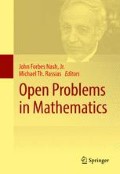Abstract
For large prime numbers p, computing discrete logarithms of elements of the multiplicative group (Z∕p Z)∗ is at present a very difficult problem. The security of certain cryptosystems is based on the difficulty of this computation. In this expository paper we discuss several generalizations of the discrete logarithm problem and we describe various algorithms to compute discrete logarithms.
Access this chapter
Tax calculation will be finalised at checkout
Purchases are for personal use only
References
Barbulescu, R., Gaudry, P., Joux, A. and Thomé, E.: A quasi-polynomial algorithm for discrete logarithm in finite fields of small characteristic, In Nguyen, P., Oswald, E. (Eds) Eurocrypto 2014, LNCS 8441, 1–16, Springer 2014.
Belding, J.V.: A Weil pairing on the p-torsion of ordinary elliptic curves over \(K[\varepsilon ]\), J. of Number Theory, 128 (2008), 1874–1888.
Buchmann, J., Jacobson, M. and Teske, E.: On some computational problems in finite abelian groups, Math. Comp. 66 (1997), 1663–1687.
Canfield, E.R., Pomerance C. and Erdős, P.: On a problem of Oppenheim concerning ‘Factorisation Numerorum’, J. Number Theory 17 (1981), 1–28.
Cheng, Q., Wan, D. and Zhuang, J: Traps to the BGJT-algorithm for discrete logarithms, LMS Journal of Computation and Mathematics 17 (2014), 218–229.
Diffie, W. and Hellman, M.: New directions in cryptography. IEEE Transactions on Information Theory 22 (1976), 587–594.
Göloğlu, F., Granger, R., McGuire, G. and Zumbrägel, J.: On the function field sieve and the impact of higher splitting probabilities. In Canetti, R. and Garay, J. editors, Advances in Cryptology—CRYPTO 2013, LNCS 8043, 109–128. Springer 2013.
Granger, R., Kleinjung, T. and Zumbrägel, J.: On the discrete logarithm problem in finite fields of fixed characteristic, Cryptology ePrint Archive: Report 2015/685.
Knuth, Donald E.: The Art of Computer Programming, vol. II: Seminumerical Algorithms, Addison-Wesley 1969.
Lenstra, H.W.: Finding isomorphisms between finite fields, Math. Comp. 56 (1991), 329–347.
Lenstra, H.W. and Silverberg, A.: Roots of unity in orders, Foundations of Computational Mathematics, to appear (2016).
Menezes, A., Okamoto, T., Vanstone, S. A.: Reducing elliptic curve logarithms to logarithms in a finite field, IEEE Transactions on Information Theory 39 (1993), 1639–1646.
Miller, G.: Riemann’s Hypothesis and tests for primality J. of Computer and System science 13 (1976), 300–317.
Miller, V.: The Weil pairing, and its efficient calculation, J. Cryptology 17 (2004), 235–261.
Panario, D., Gourdon, X. and Flajolet, P.: An analytic approach to smooth polynomials over finite fields. In J. Buhler, editor, Algorithmic Number Theory, Proceedings of the ANTS-III conference, 1423, 226–236. Springer 1998.
Pohlig, S. and Hellman, M.: An improved algorithm for computing logarithms over GF(p) and its cryptographic significance. IEEE Trans. Inform. Theory IT-24 (1978), 106–110.
Pollard, J.: Monte Carlo methods for index computation mod p, Mathematics of Computation, 32 (1978), 918–924.
Satoh T. and Araki, K.: Fermat quotients and the polynomial time discrete log algorithm for anomalous elliptic curves, Comment. Math. Univ. St. Paul. (1998), 81–92.
Semaev, I.A.: Evaluation of discrete logarithms in a group of p-torsion points of an elliptic curve in characteristic p, Math. Comp. 67 (1998), 353–356.
Shanks, D.: Class number, a theory of factorization and genera. In Proc. Symp. Pure Math. 20 (1971), 415–440. AMS, Providence, R.I.
Silverman, J.H.: The arithmetic of elliptic curves, Graduate Texts in Mathematics 106, 2nd Ed. Springer–Verlag, 2009.
Smart, N.: The discrete logarithm problem on elliptic curves of trace one, J. Cryptology 12 (1999), 193–196.
Xiao, D., Zhuang, J. and Cheng, Q.: Factor base discrete logarithms in Kummer Extensions, Cryptology ePrint Archive: Report 2015/859.
Author information
Authors and Affiliations
Corresponding author
Editor information
Editors and Affiliations
Rights and permissions
Copyright information
© 2016 Springer International Publishing Switzerland
About this chapter
Cite this chapter
Schoof, R. (2016). The Discrete Logarithm Problem. In: Nash, Jr., J., Rassias, M. (eds) Open Problems in Mathematics. Springer, Cham. https://doi.org/10.1007/978-3-319-32162-2_12
Download citation
DOI: https://doi.org/10.1007/978-3-319-32162-2_12
Published:
Publisher Name: Springer, Cham
Print ISBN: 978-3-319-32160-8
Online ISBN: 978-3-319-32162-2
eBook Packages: Mathematics and StatisticsMathematics and Statistics (R0)

